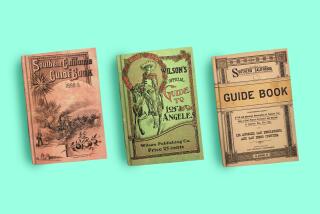Sampling the Megahertz Guides
- Share via
You can’t tuck them into the corner of a backpack or leaf through their restaurant recommendations from a cozy featherbed in an 18th century farmhouse. But while the growing ranks of online travel guidebooks may lack portability, the best offer something their paper-bound brethren can’t: Up-to-date information, often gleaned from readers themselves.
One of the newest entrants into the online arena is London-based Rough Guides, a popular guidebook series known for its candid, opinionated narratives. Last fall, Rough Guides joined forces with HotWired, the online component of Wired magazine, to put the full text of its U.S. guide on the World Wide Web (https://www.hotwired.com/rough).
The Canada and Mexico editions will be online next month. Though the print editions are revised every two years, Rough Guides’ online ventures will be updated at least once a month, promises Hotwired spokesman James Glave. But most new material will come from readers themselves: “We really want this to be a community space . . . a micro-version of Usenet discussion groups,” Glave says.
The effort has yielded mixed results: The section on the Hawaiian island of Molokai, for example, includes a reader’s intriguing tip about buying fresh-from-the-oven bread at the local bakery, but fails to note that the island’s hugely popular mule rides were reinstated several months ago. Since the online version of Rough Guide USA is advertiser supported, Internet access is free; the paper version costs $18.95.
But Glave says that while the Web guidebook serves as a pre-trip research tool, it can’t replace the “physical experience” of its paper counterpart. Travel bookstore owner Elaine Petrocelli of Corte Madera, Calif.-based Book Passage agrees. “I’m an Internet freak, but when I’m traveling I like to have a guidebook I can take to the island where there are no modems,” she says.
A sampling of online offerings from other guidebook publishers:
Lonely Planet: Though it doesn’t include full-text versions of its guidebooks, Lonely Planet’s online version nevertheless provides some of the best travel-related material on the Internet (https://www.lonelyplanet.com). The Web site supplies basic destination information, most culled from its guidebooks, for about 65 countries and 15 cities--including eight in Australia, where the publisher is based. Particularly entertaining is “Detours,” a section devoted to “lost and forgotten places.” Among them: Ulan Bator, Mongolia, where Lonely Planet reports that “local dislike of Russians is so intense that Russkies have started to don ‘I Love Hong Kong’ T-shirts so the Mongolians will think they’re tourists.” Within the next six months, Web users will be able to download updates to the guidebooks’ most recent print editions, which are revised every two to three years.
Moon: Moon’s Web site (https://www.moon.com) is best known for the cyberspace version of its “Big Island Handbook.” Produced in 1994, it includes several time-wasting sound bites from author Joe Bisignani, but does offer solid, no-nonsense information on Hawaii’s largest island. Moon’s site also includes “Road Trip USA,” an interactive guidebook-in-progress that will be published this spring.
Frommer’s: America Online users can access full-text versions of Frommer’s City Guides, which are updated annually. Series patriarch Arthur Frommer, meanwhile, just launched his own area on AOL with tips and last-minute bargains.
Traveler’s Tales: An anecdotal collection of essays rather than a turn-left, turn-right guidebook, Traveler’s Tales serve as perfect companions to more practical titles. The series’ Web site (https://www.ora.com) includes a sample essay from each of its eight editions, and the intriguing “Traveler’s Tales Web Tour” provides links to destination-related Web pages and Usenet newsgroups.
Bly welcomes reader comments; her e-mail address is Laura.Bly@latimes.com. Electronic Explorer appears monthly.
More to Read
Sign up for The Wild
We’ll help you find the best places to hike, bike and run, as well as the perfect silent spots for meditation and yoga.
You may occasionally receive promotional content from the Los Angeles Times.





